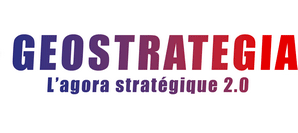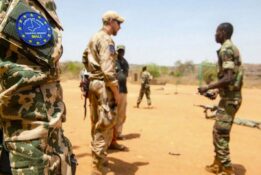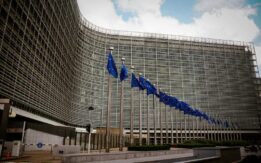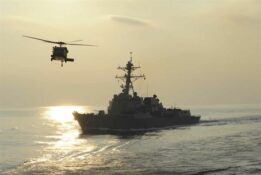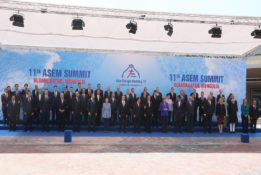Cet article s’appuie sur une analyse documentée des fragments doctrinaux nucléaires nord-coréens visant à reconstituer la logique fondamentale : préempter une décapitation du régime. Les auteurs en exposent la cohérence d’ensemble doctrinale et soulignent les évolutions de la politique nucléaire engagées par Kim Jong Un. L’Europe peut jouer un rôle accru face à cette posture stratégique nord-coréenne et l’analyse ouvre sur des recommandations dans ce sens.
Les opinions exprimées dans cet article n’engagent pas le CSFRS.
Les références originales de ce texte sont: Léonie Allard, Mathieu Duchâtel et François Godement, « Pre-empting defeat : in search of north korea’s nuclear doctrine », European Council on Foreign Relations, Novembre 2017.
Ce texte, ainsi que d’autres publications, peuvent être visionnés sur le site de l’ECFR.
Pre-empting defeat : In search of North Korea’s nuclear doctrine
It has become almost a cliché in policy circles to state that North Korea is a rational, strategic actor. But, with many in the media still describing Pyongyang as “crazy” or “suicidal”, it bears repeating. North Korea’s nuclear and ballistic weapons programmes are the product of a rational costbenefit analysis. They are founded on the regime’s calculated assessment of the threats to its survival, and their high risks have been taken into account. Still, some in Europe base their policy towards Pyongyang on misplaced ideas. They question Kim Jong Un’s rationality, and cling to the illusion that the country’s nuclear weapons are a bargaining chip rather than a non-negotiable national goal. Of course, rationality does not mean that war will always be avoided. Miscalculations and misperceptions happen. And, in some cases, war can be a rational choice.
Unlike other nuclear-armed states, the Democratic People’s Republic of Korea (DPRK) has not published a clear official statement setting out its nuclear doctrine – the circumstances under which it would launch a strike. To predict Pyongyang’s response to different scenarios, and to avoid war, the international community needs to understand how the regime sees its nuclear weapons, and when it would use them. This offers an insight into the conflict scenarios envisaged by the regime, its goals, and the options it maybe willing to consider if it judges that deterrence has failed.
For Europe, where many see North Korea as a remote and intractable problem, understanding Pyongyang’s strategic thinking on nuclear weapons is an essential step towards determining how European governments and European Union institutions can contribute to talks on crisis management. It can also help to form a realistic assessment of the results that can be expected from Europe’s current approach, which centres on sanctions. If the EU and European governments are to have a real impact on the crisis, European policymakers must accept the fact that Pyongyang is a rational actor and that there is no prospect of talks on unilateral disarmament. While Europe should continue to push strongly for nuclear disarmament as the ultimate goal in interactions with North Korea and leave no space for ambiguity, it should also explore the role it could play to prevent international divisions regarding how to respond to North Korean proliferation activities.
This paper sets out to piece together North Korea’s nuclear doctrine, drawing on original, open-source material published by the country’s official news outlets KCNA and Rodong Shinmun in the five years since Kim Jong Un came to power. These statements are aimed primarily at the domestic audience. Of course, North Korea knows that these sources are studied by intelligence services elsewhere, and so they vary between propaganda for domestic consumption and messages aimed at enemies abroad. They nonetheless include valuable information and offer a window into Pyongyang’s strategic thinking.
The paper starts by asking how far North Korea can be considered to have a nuclear doctrine, and analyses the key texts where the regime’s position can be found. It concludes that, though there is no fully-fledged doctrine, North Korea’s strategic thinking is clear and internally coherent.
The paper then maps out the key components of the emerging nuclear doctrine. First, the doctrine centres on the idea that Pyongyang is prepared to launch a pre-emptive nuclear strike in response to an imminent attack on the country. Second, the regime presents its nuclear arsenal as part of a defensive, rather than offensive, strategy: it frames the programme as a response to the risk of a decapitation strike mounted by the United States and its allies, especially South Korea. Third, North Korea lacks a clear distinction between the use of nuclear weapons against military targets and their use against civilian targets, or any plan for a gradual escalation from attacking military bases to striking cities. Moreover, the regime seems to lack any defined endgame to its use of nuclear weapons, or evaluation of the consequences of using them. In other words, it does not envisage military victory.
The paper goes on to consider how Kim Jong Un has changed his country’s nuclear policy. The current leader has ended any ambiguity around North Korea’s intention to remain a nuclear power, and has made it clear that he will not consider disarming. Under Kim Jong Un, official statements place increasing emphasis on diversification of the nuclear arsenal – crucially, this would increase the arsenal’s chances of surviving a first strike and achieve credible deterrence. North Korea’s nuclear doctrine is determined to a great extent by its technological limitations. Without certainty that its arsenal could survive a first strike by its enemies, Pyongyang’s deterrence relies on the threat of launching the first strike itself.
Finally, the paper offers suggestions for how European governments and EU institutions can reduce the risk of war. They should strengthen sanctions on North Korea, and take steps to prevent sanctions evasion in third countries, so as to make clear the cost of illegal proliferation. At the same time, they should offer to host “track 2” crisis management talks between non-governmental actors in countries facing North Korea’s nuclear programme. European “track 2” diplomacy with North Korea already exists. What is needed is a platform to explore crisis scenarios to lessen the chance of misunderstanding between the other parties.
Elements of a nuclear doctrine
Military doctrines exist to make clear – both internally and to adversaries – the circumstances under which a state will resort to various forms of military action. Unlike other states that have developed a nuclear arsenal, North Korea lacks any official document that sets out its nuclear doctrine to the outside world, such as China’s defence white paper, Russia’s official military doctrine, or the United States’ nuclear posture review reports.
However, Pyongyang communicates regularly on its nuclear arsenal through the official media, mostly in the form of statements from the leadership, and more often than not in the name of Kim Jong Un. It has also passed legislation on nuclear weapons that includes elements that come close to a doctrine.
In contrast to much Western media coverage – where Pyongyang’s statements on its nuclear weapons are portrayed as crazed threats – there is a strong internal coherence to the information parcelled out in Koreanlanguage open source material. This suggests a high degree of clarity in the government’s strategic thinking, though, of course, there is likely to be a large amount of bluff mixed in with more credible information.
Kim Jong Un has set out to modernise and professionalise government communications. Compared to the era of his father, Kim Jong Il (1994-2011), the circle of “nuclear narrators” – those making statements on North Korea’s nuclear policies – has widened somewhat. These now include military leaders such as the chief of staff of the Korean People’s Army, his deputy, the minister of the armed forces, senior officials from the State Council, and the heads of academic research centres.
The official term that is closest to the concept of a nuclear doctrine (핵정책) can be translated as “nuclear policy” – a broader term that is not limited to the circumstances in which nuclear weapons might be used. The regime’s statements on this nuclear policy set out scenarios and circumstances for the use of nuclear weapons on a level that almost qualifies as a doctrine. The official document that comes closest is the 2013 “Law on Consolidating the Position of Nuclear Weapons State”.[1] Its primary goal was to formalise North Korea’s claim to nuclear power status, translating into domestic law an April 2012 revision to the constitution, which declares that the country is a nuclear power.[2]
The law provides a broad framework to understand the circumstances under which North Korea envisages using nuclear weapons. First, it makes no distinction between conventional and nuclear attacks against the country, stating that nuclear weapons would be employed in response to an attack with conventional weapons. Second, it characterises the nuclear arsenal’s role as “deterring and repelling the aggression and attack of the enemy” and as a means to strike “deadly retaliatory blows at the strongholds of aggression until the world is denuclearised”.[3] If deterrence fails, and another nuclear state launched an attack against North Korea, a nuclear strike would be used to “repel invasion or attack from a hostile nuclear weapons state and make retaliatory strikes”.[4] Third, the law states that North Korea rules out nuclear strikes against non-nuclear states “unless they join a hostile nuclear weapons state in [an] invasion and attack on the DPRK”.[5] This is a threat aimed at South Korea and Japan, and any other US allies who might join an international coalition in case of war.[6]
The choice of a pre-emptive strike
The sources make clear that North Korean thinking on nuclear weapons centres on the concept of a pre-emptive strike. North Korean publications and official statements have consistently referred to this option since Kim Jong Un came to power in 2012. However, the approach is not entirely new. A 2008 article in KCNA emphasised that pre-emptive strikes are “not a monopoly of the United States, we also have the option […] if we feel the need, we will go to that option.”[7]
The sources make a clear distinction between preventive and pre-emptive strikes: in general, while a pre-emptive strike is aimed at stopping an imminent attack, a preventive strike aims to prevent an enemy developing, or using, certain military capacities. The latter is never mentioned in the sources as a strategic option. Instead, the key term used in North Korean official statements and media articles is “preemptive attack/attack of our style” (우리 식의 핵선제타격).[8] The sources do not define the exact nature of such a “preemptive attack”, but make clear that it is linked to two of the greatest threats that North Korea considers itself to be facing. These are the US refusal to rule out a first nuclear strike, and the discussions between South Korea and the US on the possibility of a decapitation strike against the regime.[9] According to media reports, a plan jointly adopted by the South Korean and US militaries in 2015 – Operations Plan 5015 – sets out operations against the North Korean leadership, and discusses pre-emptive responses to any signs of a North Korean attack.[10] South Korea and the US have rehearsed elements of the plan in joint military exercises.
The North Korean narrative emphasises pre-emptive nuclear strikes as a response to an imminent attempt to destroy North Korea. For example, Li Yong Pil, director of the foreign ministry’s Research Centre on the United States, states that “a pre-emptive nuclear strike is not something the US has a monopoly on. If we see that the US would do it to us, we would do it first. We have the technology”.[11]
In February 2016, the Supreme Command of the Korean People’s Army published an “operational scenario” that again emphasises pre-emption.[12] It states: “From this moment all the powerful strategic and tactical strike means of our revolutionary armed forces will go into pre-emptive and [justice] operation” against “the enemy”. Though the document does not use the term “nuclear”, there is calculated ambiguity. It mentions a “strategic strike”, which is an indirect reference to nuclear weapons. It also states that a first strike would target the presidential Blue House in Seoul, again without making clear whether this would involve nuclear weapons. Instead, that first strike is called a “crucial warning” before a “second operation to totally eliminate [the enemy] at its source.” The document also names US bases in the Asia-Pacific region, from which attacks on North Korea would be conducted, and the US mainland as targets for a “second strike.”
The strategy of pre-emption is particularly dangerous given the country’s limited intelligence and reconnaissance capabilities, which North Korean sources indirectly acknowledge. It does not take much reading between the lines to conclude that large-scale US-South Korean military exercises could lead to a disastrous miscalculation by North Korea. Lacking reliable intelligence, the Korean People’s Army could easily conclude that military operations by the US around the peninsula were the first step in an imminent attack to achieve regime change and nuclear disarmament, resulting in a pre-emptive nuclear strike by Pyongyang. US-South Korean joint exercises are particularly risky because they include units that would likely be involved in any decapitation strike.
Nuclear strike targets according to north korean sources (SOURCES : SEE Endnotes)
Pre-emption in practice
From the North Korean sources, one can compile a list of possible targets for a nuclear strike. There is no preference for “counterforce” strikes against military targets, as opposed to “countervalue” strikes against civilian targets – both are mentioned in official statements and media reports. Pyongyang repeatedly threatens both US bases in the Asia-Pacific and cities on the US mainland, while the media repeats the threat that North Korean “strategic forces” are ready at any time to strike “the US mainland, their stronghold, their military bases in the operational theatres in the Pacific, including Hawaii and Guam, and those in South Korea.”[13] Japanese and South Korean cities are also designated as targets. Japanese cities are more explicitly targeted, including in a list that names “Tokyo, Osaka, Yokohama, Nagoya, Kyoto.”[14] More recent statements include the vague notion of reaching “major strike objects in the operation theatres of South Korea.”[15]
North Korea has also released maps of its targets, as exemplified by the infamous photo, published in March 2013, that shows Kim Jong Un with a target map corresponding to cities and bases in the US mainland.[16] In addition, a July 2016 picture of Kim Jong Un during a ballistic test launch shows him looking at a map of the US military base in Busan.[17] Numerous video-montages presented Guam as a target, before Pyongyang designated the waters around the island as a target for missile exercises in August 2017.[18]
Nuclear strike targets according to north korean sources (SOURCES : SEE Endnotes)
Deterrence or aggression ?
The North Korean sources consistently refer to nuclear weapons as part of a defensive, rather than an offensive, strategy. They never mention the possibility of using the country’s nuclear capacity for blackmail – to coerce or intimidate South Korea and Japan – or to carry out acts of terrorism. Nor does the literature discuss using nuclear weapons as cover to carry out conventional strikes without facing retaliation. A scenario under which North Korea uses conventional weapons to change the territorial status quo on the peninsula by force, shielded by its nuclear capacity, is never mentioned. This does not mean that the option is not under discussion in Pyongyang: in 2010, after sinking a South Korean navy ship and shelling an island, Pyongyang threatened massive retaliation if South Korea conducted any hard reprisal: in other words, it used its deterrence as a shield for aggression when its nuclear programme was much less advanced than today. But this has not entered the official discourse, which is focused on deterrence. Indeed, the regime often deploys a quasi-moral argument – that its nuclear weapons are merely a defence against regime change – and uses the term “pre-emptive nuclear strike of justice”.
North Korea leaves some aspects of its policy vague. The sources do not make a distinction between deterrence by punishment (carrying out retaliatory strikes to raise the cost of any attack on North Korea) and deterrence by denial (persuading the US and South Korea that they would not achieve their objectives in a war – i.e. the fall of the current regime). This might be because the latter is not considered credible, given a balance of power that is overwhelmingly in favour of the US-South Korea alliance.
The sources distinguish between tactical and strategic weapons, but do not place them in a hierarchy or sequence. There is no universally accepted definition of tactical as opposed to strategic nuclear weapons, but the terms are most often used to describe counterforce strikes on the battlefield, in contrast to countervalue strikes against civilian targets. Some analysts define tactical weapons on the basis of their smaller yield or shorter range. North Korean sources do not offer a clear definition of the distinction. By contrast, France’s cold war doctrine, for example, stated that there would first be a warning tactical nuclear strike targeting invading conventional forces from the Soviet Union, before escalating to a strategic countervalue strike against civilian targets, if the first did not halt the aggression.
In North Korea’s literature there is no such notion of gradual retaliation.[19] The only element that comes close is an assertion that North Korea will show its military power “step by step”. But the literature does not set out any clear sequencing of either conventional weapons or weapons of mass destruction.[20] The sources never explicitly mention the existence of a stockpile of biological and chemical weapons, or how these might be integrated into the country’s military operations. Yet the use of a VX nerve agent in the February 2017 assassination of Kim Jong Un’s half-brother in Malaysia can be seen as evidence that such a stockpile exists.
Strikingly, the sources do not identify a political endgame to the use of nuclear weapons. They bluff by referring to the destruction of the US, but never discuss the reunification by force of the Korean peninsula. Missing from the open source material is any evaluation of the consequences of striking the US or its allies with nuclear weapons, or of a clear threshold between a nuclear strike against a military base and a nuclear strike against a city.
In sum, North Korea has no clearly defined concept of tactical use of nuclear weapons, though the distinction between striking military bases and cities is very much present. Arguably, given the geographic configuration of the Korean peninsula and the location of US bases in South Korea and Japan, no use of nuclear weapons could be considered as merely tactical. There is no way to target military forces without killing civilians, and there would be little difference in the political effects. In addition, Pyongyang refuses to make a clear choice in its official communications between retaliatory nuclear strikes and deterrence by denial, or to define a sequence of escalation from strikes against military facilities to destruction of cities. In theory, any attack against the country could therefore result in nuclear strikes against military or civilian targets. This looks like an attempt to strengthen deterrence by leaving all options on the table.
What Kim Jong Un has changed
In just over five years in power, Kim Jong Un has already placed his personal imprint on the country’s nuclear programme. He has not only increased the frequency of nuclear and missile tests, but has also fundamentally altered the strategic thinking and communications around nuclear weapons. Kim Jong Un has ended the ambiguity around the nature of the country’s nuclear programme: its arsenal “is not a bargaining chip to be put on a negotiating table.”[21] One of his first moves was to formalise the country’s status as a nuclear power in 2012, adding the following sentence to the constitution: “Kim Il Sung… turned our fatherland into an invincible state of political ideology, a nuclear armed state and an indomitable military power”. Nor does anyone in the international community still seriously consider the programme as mere leverage to obtain mutual recognition with the US or to extract economic concessions and security guarantees.
The official language used under Kim Jong Un marks a clear break with his father’s era. Under Kim Jong Il, denuclearisation was still mentioned as a possible outcome of diplomatic talks. For example, a 2010 foreign ministry reference document on the “nuclear policy of North Korea” explained that “the realisation of denuclearisation requires mutual trust”.[22] In contrast, under Kim Jong Un the country has clearly expressed its determination to make no concessions on its status as a nuclear power. Official sources often mention regime change and war in Libya, Iraq, and Ukraine as being a result of these countries abandoning their nuclear arsenals. They brush aside the Iran nuclear deal, arguing that North Korea’s situation is “completely different from Iran”, because it “is a nuclear weapons state in both name and reality” with its “own interests.”[23]
On the foreign policy front, Kim Jong Un has made clear that he wants international recognition of North Korea as a nuclear state. In 2016, he stated: “Now that our Republic has the status of a dignified and independent nuclear power, we should develop our foreign relations accordingly.”[24] North Korea’s insistence on independence leads it to reject all other models, or to conceal their influence. Pakistan, for example, could serve as a model of a state rebuilding its ties with the international community after illicitly gaining nuclear power status, but is never cited.
It is well known that the ballistic programme has accelerated under Kim Jong Un. The increased frequency of tests is the most visible aspect, but it is also noteworthy that the country is now developing multiple types of missiles. Fifteen types have been tested under Kim Jong Un, compared to five under Kim Jong Il, and five further types have been spotted in official photographs.[25] Three key concepts that have appeared in state media under Kim Jong Un are at the centre of the regime’s nuclear strategy. These are: the hydrogen bomb, also known as a thermonuclear weapon, which is more powerful than the traditional atomic bomb; miniaturisation – the ability to make weapons small enough to fit on to a long-range missile; and diversification of the types of nuclear weapons. Of the three, diversification is the most important in terms of its impact on North Korea’s military options. The other two relate to the construction of a deliverable nuclear weapon, while diversification could increase the arsenal’s ability to survive a first strike or attempts to intercept it in flight. This “survivability” is crucial if North Korea is to achieve its goal of deterrence by punishment.
Diversification often appears in the sources. They refer to the goal of achieving the “three components of nuclear deterrence” – namely the nuclear triad at the core of other countries’ doctrines, made up of land-, air-, and sea-based means of launching missiles.[26] Kim Jong Un speaks of “all possible military actions as a nuclear power”,[27] and states that the diversification of delivery vehicles allows “the realisation of our military objectives, we need diversified nuclear weapons…Depending on the destructive power and maximal range, the weapon is tactical or strategic. Depending on the shape or use of nuclear munitions, the weapon can be classified as nuclear warheads, nuclear bomb, nuclear torpedoes, nuclear mines etc.”[28] While there is no evidence yet that the country is pursuing nuclear torpedoes and mines, it would not be surprising given the emphasis on diversification.
The logic of pre-emption
Pyongyang’s official statements show that it is prepared to carry out a pre-emptive nuclear strike, that it would consider strikes against both military and civilian targets, and that it is focused on deterrence by punishment, but dreams of achieving deterrence by denial. This does not constitute a fully formed doctrine, but the beginning of doctrinal thinking. Taken together, these elements evoke the model of “asymmetric escalation” described by nuclear scholar Vipin Narang. For Narang, asymmetric escalation is a posture adopted by states trying to deter more powerful adversaries from launching conventional or nuclear attacks by threatening to use nuclear weapons first.[29]
However, North Korea is not a perfect manifestation of the asymmetric escalation model. The model requires two elements that are not present in the North Korean posture: transparency on strike capacities, in order to give credibility to the threat of first use; and delegation of command and control, so that missiles would still be launched in the event of the leadership being destroyed.[30]
However, the model highlights how far the unfavourable balance of power determines Pyongyang’s choice of preemption. One element has particular importance: the uncertainty around whether the arsenal could survive a first strike by the US. As Donald Trump stated in his September 2017 speech at the UN General Assembly, the US military has the capacity to “completely destroy” North Korea.[31] This overwhelming nuclear and conventional superiority of the US must be the starting point for understanding North Korea’s emphasis on pre-emption.
By contrast, China’s strategic depth – its large size and population – led it to adopt a doctrine of “no first use”, because it believed that neither its government nor its nuclear arsenal could be eliminated in a first strike by a hostile power. Over time, China has expanded its second strike capabilities, to enable what Beijing calls “nuclear counterstrike campaigns”.[32] North Korea currently has no significant second strike capability, and the government is concerned that a first strike could destroy it. The credibility of its deterrence therefore lies in the capacity to inflict unacceptable damage on an enemy at a very early stage of a military conflict, before the regime can be destroyed. This results in a policy of nuclear pre-emption.
Kim Jong Un was responsible for adopting, or at least publicising, the policy of pre-emption. But there is a degree of continuity in the country’s approach to deterrence between its nuclear and its longer-standing weapons of mass destruction. Pyongyang developed biological and chemical weapons with a similar strategy before Kim Jong Un came to power, and the nuclear missiles threatening Seoul follow from the same logic, even if the outcome of any military conflict would be the defeat of North Korea and most probably the end of the current regime. This was described under previous leader Kim Il Sung as a “scorpion strategy” – in a war, North Korea would only be able to strike once before defeat.[33]
The power imbalance also dictates that the ability of the nuclear arsenal to survive an attack is a key element of North Korea’s thinking on pre-emption. Without this, no credible deterrence can be achieved. North Korea’s adversaries must believe that their first strike would not be sufficient to destroy the country’s nuclear strike capability. Of course, North Korea suffers from a credibility gap regarding its strike capabilities. Analysts doubt that it has mastered miniaturisation (the ability to fit a nuclear warhead onto a ballistic missile) or re-entry (the ability of its missiles to survive re-entering the earth’s atmosphere). There are many questions around the country’s claim to possess thermonuclear weapons. However, there is general recognition that North Korea has a rudimentary nuclear strike capacity.
What North Korea has convincingly conveyed, through its aggressive statements and its acceptance of high risks, is its resolve to launch a pre-emptive strike in case of war. The credibility of its deterrence relies on its tough rhetoric rather than on transparency about its capabilities. As a result, despite the devastating retaliation that a North Korean first strike would invite, the pre-emptive posture of Pyongyang is partly credible. It is at least sufficiently credible to instil doubt among those who think that North Korea would not respond to a preventive attack against its missile and nuclear sites. This is because, as a rational actor, it would calculate that escalation will ultimately lead to regime collapse.
A great deal of ambiguity surrounds the situation in terms of North Korea’s actual capacity to pre-empt decapitation with a nuclear first strike. But ultimately North Korea’s quest for deterrence is determined by two dimensions. From North Korea’s perspective, striking first would be a rational act, because at the present time the regime would be unlikely to survive a first strike from the US; if it fears it is about to be struck, it might as well strike first. From the point of view of the US, meanwhile, if it did strike, it cannot be sure of complete elimination of North Korea’s capacity to strike with nuclear weapons in the early stages of the conflict. What would North Korea do if in the future it possessed a large arsenal of thermonuclear weapons and intercontinental ballistic missiles that could reliably re-enter the earth’s atmosphere and be launched by submarine? The doctrine could well change in that case, though it is unlikely that North Korea will declare a no first use policy as long as it considers that the risk of decapitation or preventive attack is still there. In any case, the credibility problem of any no first use doctrine would remain: it can easily be changed when war breaks out.[34]
What can Europe do?
Europe is a long way from the Korean peninsula. Although some European militaries could be involved if war broke out, there is reluctance in certain European states to pay sufficient attention to the issue. Despite strong links with South Korea, many European policymakers perceive the peninsula as a lost cause, a place where they lack leverage, and where their direct security interests are limited. This is a mistake. Given the high stakes for international security and for the rules-based order, the current unravelling of the non-proliferation regime – driven by Pyongyang – undermines Europe’s long-term interests. If nothing else, it is worth considering the danger of triggering proliferation among Europe’s neighbours. Europe’s reflections on how it can lower the risk of war and promote North Korea’s nuclear disarmament should start from a cool assessment of Pyongyang’s strategic calculations, and an understanding of the logic of pre-emption. This study provides a starting point. It points to a high risk of catastrophic miscalculation and misperception on the Korean peninsula. Under the logic of pre-emption, any military move that is misinterpreted by North Korea as the beginning of a decapitation effort would lead to a nuclear first strike by Pyongyang. This study also makes clear that no incentive will be sufficient to peacefully negotiate North Korea’s nuclear disarmament. Given the high risks, and Europe’s limited leverage, European governments, an the EU’s European External Action Service (EEAS), should
focus on two courses of action that add clear value, rather than setting their sights on unrealistic goals.
- Back sanctions to control proliferation
European countries and institutions should strengthen the sanctions regime against North Korea, but abandon the idea that sanctions alone will create the conditions for nuclear disarmament. North Korea’s nuclear weapons are a nonnegotiable national goal and a central part of the regime’s survival strategy. However, strengthening the sanctions regime is still important. Sanctions aim to attach a high cost to illegal proliferation and send a strong signal to the international community about the consequences of violating international law. They also slow North Korea’s programmes. The reports of the UN expert panel on implementation of the sanctions regime cite many cases of evasion. Europe should allocate resources to ensuring strict implementation of the regime, both within its borders and in countries where it has influence, especially on its periphery. In the last two years alone, several cases of sanctions evasion have been reported in Egypt and Ukraine. Europe should also strengthen its message on sanctions regarding China, in order to persuade the Chinese leadership to more effectively implement United Nations Security Council resolutions North Korean leaders need to be faced with an international community that is united on sanctions. - Host “track 2” crisis management talk
A European attempt at mediation would be seen by all parties as a win for North Korea. But Europe may be well placed to draw out the differing risk perceptions of countries that are more directly involved in dealing with North Korean proliferation activities and provocations – namely the US, China, Japan, Russia, and South Korea. Expert meetings, eventually with officials attending, could be encouraged by the EU and/or European states. What would be the reaction to an American interception of a North Korean ballistic missile test? How would they handle a major radiation leak in north-east Asia after a nuclear accident in North Korea? Do they all agree that testing a nuclear device in the atmosphere is a red line that will invite military action? Many questions remain on how states would respond to such crises and other scenarios. Europe could help to move forward thinking on the steps that can be taken to mitigate risks, especially risks linked to accident misunderstandings, and also division of the international community during crises because of mistrust. European governments should host “track 2” talks between policy experts and military analysts in the relevant countries. This could eventually evolve into confidential “track 1.5” talks – involving officials as well – about the risks of escalation, and contingency plans, starting with Europeans themselves and the coordinated evacuation of nationals from the Korean peninsula. Contingency planning is not limited to the US and China, even though the apparent lack of direct crisis management talks between the Chinese and the US military is particularly problematic. China has so far eschewed any contingency talks with the US that might, even inadvertently, signal a willingness to abandon the North Korean regime. Given Pyongyang’s focus on pre-emption, such talks are needed to avoid incidents that might quickly escalate to nuclear use, and to plan responses to incipient crises. It is not realistic to include North Korea in these talks, but the EEA may be able to organise crises simulations to map out the contingency plans that should be adopted by each of these parties to guide their response to an erupting crisis. To Pyongyang, including at the “track 2” dialogues that are hosted separately by some Northern European think-tanks, Europeans should constantly signal that nuclear disarmament remains for Europe the only solution, and the sole reason for engagement with North Korea.
North Korea is not Iran. At a minimum, the advanced level of the country’s nuclear programme, and its efforts to become a recognised nuclear state, should make it clear to us that negotiated disarmament will at best require pressure that go beyond sanctions regime and much more unity between the key stakeholders on North Korea. The “dual freeze” idea promoted by China and supported by Russia – exchanging a freeze on North Korean nuclear and ballistic missile tests for a freeze of US-South Korean joint military exercises – s not satisfactory either, without credible safeguards to prevent the usual North Korean violations. Inducements for North Korea can only follow demonstrated and verifiable steps towards nuclear disarmament. Absent this, Europe should be realistic: it should focus on contingency plans and dialogue on measures to contain the scale of any conflict.
References
Par : Léonie ALLARD, Mathieu DUCHÂTEL, François GODEMENT
Source : European Council on Foreign Relations
Mots-clefs : Kim Jong-Un, North Korea, nuclear doctrine, nuclear strike, pre-emption

